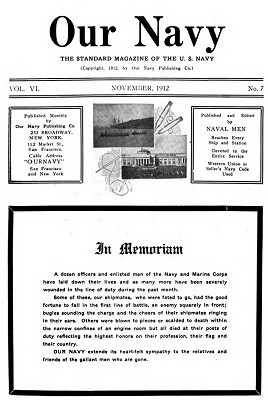Riding
the Surfboard
By DUKE PAOA
(Duke Paoa was born on
the island of Oahu, within sound of the surf, and has spent half
of his waking hours from early childhood
battling the waves tor sport.
He is now 21 years of age, and is the
recognized native Hawaiian champion surf rider.
Duke and the members of the Hui Nalu,
an organization of professional surfers at Waikiki,
have supplied the material for this
article on the national sport of Hawaii.)
These photographs
of Surfriding are from the negatives of Alfred R.
Gurrey, Jr.,
and some of the results of
three years work in surf
photography.
It necessitated going right out
against the incoming surf, right at its height,
and meant invariably a swamping of
the canoe and soaking for all in it.
Mr. Gurrey felt amply repaid for his
day's outing if at the end of the day he
returned with his camera and one
unspoiled negative out of twelve.
Would you like to stand like a god before the crest of a
monster billow, always rushing to the bottom of a hill and
never reaching its base, and to come rushing In for half a
mile at express speed, in graceful attitude, of course,
until you reach the beach and step easily from the wave to
the strand?
Find the locality, as we Hawaiians did, where the rollers
are long in forming, slow to break, and then run for a great
distance over a flat, level bottom, and the rest is
possible.
Perhaps the ideal surfing stretch in all the world is at
Waikiki beach, near Honolulu, Hawaii.
Here centuries ago was born the sport of running foot races
upon the crests of the billows, and here bronze skinned men
and
women vie today with the white man for honors in aquatic
sports.
There are great, long, regular, sweeping billows, after a
storm at Waikiki, that have carried me from more than a mile
out at sea right up to the beach; there are rollers after a
big kona storm that sweep across Hilo Bay, on the Big Island
of Hawaii, and carry native surfboard riders five miles at a run, and on the
Island of Niihau there are even more wonderful surfboard
feats performed.
A surfboard is easy to make.
Mine is about the size and shape of the ordinary kitchen
ironing board.
In the old days the natives were wont to use cocoanut logs
in the big surf off Diamond Head, and sometimes six of them
would come in standing on one log, for, of course, the
bigger and bulkier the surfboard the farther it will go on
the dying rollers; but
it is harder to start the big board, and, of course, on the
big logs one man, the rear one, always had to keep lying
down to steer the log straight with his legs.
At Waikiki beach, Queen Emma, as a child, had a summer home,
and always went out surfing with a retainer, who stood on
the board with her.
Today it is seldom that more than one person comes in before
the wave on a single board, although during the past year
some seemingly wonderful feats have been attempted.
I have tried riding in standing on a seven-foot board with a
boy seated on my shoulders, and now I find it not impossible
to have one of my grown companions leap from his board,
while it is going full speed, to mine, and then clamber up
and twine his legs about my neck.
Lately I have found a small boy, part Hawaiian, who will
come in with me on my board, and when I stand, he stands on
my shoulders, and even turns round.
To quote from Alexander Hume Ford, editor of the Mid-Pacific
Magazine, who organized the Surf riders Club at Waikiki:
Surfboard riding is an art easy of accomplishment to the few
and difficult to the many.
It is at its best when the rollers are long in forming, slow
to break, and, after they do, run for a great distance over
a flat, level bottom, such as the coral beds at Waikiki,
which is perhaps the all-year-round ideal surfboarding bit
of water in the whole world. There are three surfs at
Waikiki: the "big surf" toward Diamond Head, in front of Queen
Liliuokalani's summer residence, where the most expert surfboard riders and the native boys disport
themselves; the "canoe" surf, nearly in front of the Moana Hotel, where the
majority of those who stand on the board dispute rights with
the outrigger canoes that come sliding in from a mile out at
sea before the monster rollers; and the beginners, or
cornucopia surf- a series of gentle rollers before the
Outrigger Canoe
Club's grounds and the Seaside Hotel.
Here, as a rule, beginners learn the art of balancing on the
board.
The water for several hundred yards out is but waist deep,
so that the mallhini [sic] (new-comer) can stand beside his board, wait
for a wave, give his board a forward push, jump on, and race
in toward the beach before the foaming crest.
He quickly learns, lying down, to guide the board by moving
his legs, like a rudder, from one side to the other.
There is nothing difficult in mastering this portion of the
art or surfing, but out in the deepwater it is quite another
proposition. There you have no foothold from which to gain a
start, which must now be given the board by the power of the
hands.
It is half a mile out to
Page 14
ON THE CREST.
Copyrighted by A. R. Gurrey, Jr |
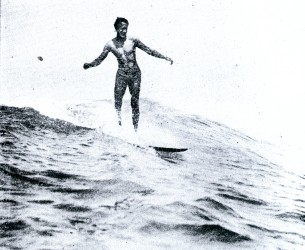 |
the big waves, or "nalu nui," and a long
"hoe,' as the overhand windmill stroke that takes you out is
termed.
The intending surfer launches his board by grasping it in
both hands by the edges, so that it balances, rushes down
the slightly sloping beach, and throws himself upon the
board as he casts it upon the waters with a forward movement
that gives it a good start and sends it beyond the first row
of little breakers.
Then begins that constant, steady, windmill movement of the
arms, the hands acting as paddles, and the six or seven-foot
plank
of light wood swiftly glides out to sea.
To the beginner the exercise soon tires to exhaustion; the
neck and back ache, and the points of the ribs that touch
the board seem to cut through the flesh.
Perseverence, however, overcomes all obstacles, and after a
few days new muscle is developed and the stiffness is
forgotten.
Out in the deep surf, the board goes outward under the
waves, a diving tip being given the board just as it bucks
each on rushing breaker.
Once out where the waves foam, the surfer sits on his board,
which, of course, sinks until only an inch or so of the tip
is above water, and waits for the wave.
Several may pass, then afar off he notices the one he wants.
It is coming onward, a great, green roller with a ridge of
almost imperceptible spray along its entire length.
This is the wave that will curl and break to perfection,
then rush on for hundreds of yards - a Niagara of foam.
The line of surfers prepares, and as the base of the
mountain of water reaches them, there is vigorous and deft
paddling with all the strength that skill can put into
trained arms, and the great effort is made.
Some rise rapidly to the crest of the billow and sink behind
it; they have lost the wave.
Others keep down in the hollow just before the wall of
green.
It breaks, and these fortunates are lost in the foam, rise
through it, standing on their board, are lifted to the top
of the white crest, and by skillful balancing, and guiding
their boards with their feet, send them down in the bias
until once more they are in front of the on-rushing mass of
water.
Some of the boards, of course, are divorced from their
owners and go sailing in the air, while the surfer dives
involuntarily toward coral.
Few, however, are the accidents of surfing, and it is
doubtful if anyone has ever been seriously injured at this
sport which has come down to the "haole" from the old kings
of Hawaii.
For several years past the sport of surfing had been on the
decline, for as the vacant lots facing the beach at Waikiki
were taken up by private ownership, the small boy of
Honolulu was forced to give up his favorite sport.
It was on account of this injustice to the small
Page 15
Copyrighted by
A. R. Gurrey, Jr.
THE MALHINI SURF.
|
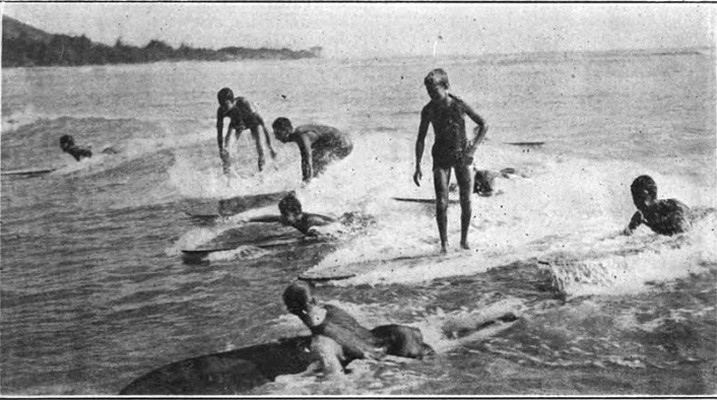
|
boy that the Outrigger Club was formed in
April, 1908.
The club soon numbered several hundred members.
New members were taught to ride stand-upon the surfboard,
and so popular became the revival of the old Hawaiian sport
that even the ladies began to take a deep interest in it.
A number of young girls have learned to stand upon their
boards, riding the waves, and together with their mothers
and older sisters have organized an auxiliary club.
Neither surfboarding nor driving the big native canoes
safely before the roughest waves are accomplishments beyond
the acquirement of the "haole" or white man.
There are white boys fully as expert as any Hawaiian youth,
both in the canoe and on the surfboard.
A white lad was the first to win a cup at a carnival of
surfriders.
Mark Twain tried to master the art of riding the surfboard,
many, many years ago.
He describes in vivid pen pictures the Hawaiian boys and
girls who danced upon the tips of the biggest breakers, and
how his board started by a big kanaka, caught a wave and
shot with express speed toward the beach, while he shot with
equal rapidity down toward the coral bed beneath the waters
of Waikiki bay.
It is difficult to learn to ride the surfboard without an
instructor, but a few simple hints will enable anyone to
master the art.
I quote from one who learned and wrote of his experiences:
The small boys of Waikiki took me in hand when I was ready
to take my first lesson on the surfboard.
It is their delight to initiate the malihini (stranger).
Few of them get beyond the initiatory exercises.
I was given a board, a bit or redwood, pointed at one end,
not six feet long, about sixteen inches wide and perhaps an
inch and a half thick.
"Just follow us,'' called one of the three eager tutors
selected from the delighted group of would-be instructors.
Soon we were out in deep water.
Nearly a mile out at sea the big, long billows, for which we
were headed, began their thrilling run, to break and reform
thrice before reaching the beach.
The first bit of advice from my tiny tutors was: "If a
breaker does strike us, just duck the bow of your board and
it will go through."
Each of the youngsters was now lying flat on his board, the
tips of his feet just lapping over the end, and the small
arms revolving
like windmills as the three boards flew through the water,
while mine lumbered on far behind.
"Come on!" they called in chorus, and I tried to obey.
The windmill motion consists of keeping the arms going
around like the sails of a windmill on either side of the
board, and strange to say, once the muscles of the arms and
shoulders are accustomed to this motion, it tires less than
any regular form of swimming.
The first of my troubles was that my chest where it rested
on the board began to chafe and ache; this the small boys
pleaded with me not to mind, as In a day or so I would not
notice it at all; this I later found to be true,
Page 16
SHOREWARD
BOUND.
Copyrighted by A. R. Gurrey,
Jr.
|
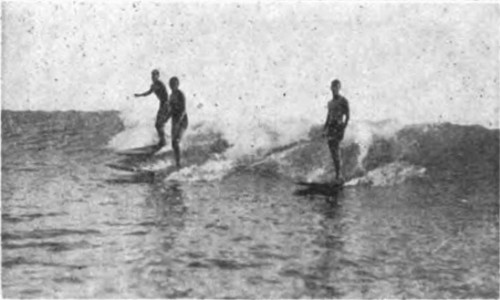
|
but that first afternoon it did not seem
possible that my ribs would not in time wear through the
skin.
However, I struggled on, and we approached the great
rollers.
The first wave we permitted to pass under us; than there was
a cry of "nalunui" (big wave coming); then "Hoe!—Hoe!" I
felt my-
self lifted on the advancing slope of the on-coming billow,
three pairs of active young muscles gave my board a great
start forward, onward and downward as though shot from a
cannon.
I was well forward on my board - in accord with instructions
carefully instilled, my feet flew up into the air - I clung
to the bow of my plank and with it did a series of
cart-wheels to the accompaniment of a chorus of cheers and
shouts of laughter; the small
boys had also plunged forward, using their bodies as
animated surfboards, and were riding my wave au-naturel.
As it finally passed me by and I came up its rear I could
see their smiling, happy faces on its crest turned toward
me.
There was a chorus of "You were too It did, but the board
was left behind.
Other youngsters, of all shades and complexions, and far
forward on your board," an exchange of gleeful chuckles, and
the three youngsters descended on my side of the wave to
give me the second degree.
"Always let your board go when she starts to dive," one of
them urged, "because sometimes if the surf is very high she
goes down 'til she strikes coral at the bottom."
Another of these cheerful, charming youngsters now thought
it time to ask if I could swim.
It seems there are persons foolish enough to come out half a
mile from shore on a surfboard who cannot swim a stroke.
I assured my initiators that I could swim, and, their
conscience at absolute peace, they prepared to proceed with
the grilling.
I was told to hold the board amidship and half kneel; it was
explained that in this posture the wave
The advancing water caught it and I lunged would strike and
carry me on at great speed, gleaming hides, that shone
dripping and resplendent in the sun, had now gathered to
witness the sport, and everyone was invited to participate
in the giving of the great third degree.
I have a vivid recollection of strange shouts, my board
almost jerked from under me, shot forward, and I, surrounded
by the white, foaming water, began sinking downward as on a
toboggon slide, yet onward with the speed of a cannon ball -
the spray almost blinding and strangling me; then as I sank,
clinging to my board, halfway down the slide of the wave, I
could begin to take notice.
On either side of me were my angelic tormentors, standing
erect on their boards, shouting encouragement and urging me
on - as though I could stop in that mad rush of waters, even
if I wished to.
From the crest of the wave a brown skinned native Hawaiian
dived from his board and arose beside me to shout confusing
orders in my face - from the other side another youngster
dived from his board and arose to grasp mine.
It tilted, and there was a shout of glee; it took the great
green wall of water on the bias, skimmed along at
accelerated speed - diagonally - and I could see the havoc
that was coming; boards dove under me - boys over me, and
one landed on the small of my back; there was a general
confusion and mix up in the seething waters, and I emerged
from the third degree coughing and spluttering to be taken
In hand for my diploma and final 33rd degree.
I was to stand on my board.
The wave came, the start was made, and my bit of wood was
fairly caught In the rush of waters.
Steady and even she rode the wave, then the cry came to
"stand!"
I tried it.
There was a rapid divorce from my board; we met later, and I
was pulled away from the wreck.
Unanimously it was agreed that I had earned my diploma, and
was worthy to learn the art of riding a surfboard.
"But I can ride," I expostulated.
There was a roar of hilarious, derisive laughter, and one of
the youngsters cried:
"Come on, then - let her go!"
Instantly all hands began to paddle - the windmills were in
full swing and the boards shot through the waters (all but
mine), caught the advancing slope, slid downward, and were
carried in in the rush.
I sank back behind the wave with my board as though I had
never made an effort to go forward.
Again and again the attempt was made, and again and again
failure was the result.
It was easy enough to understand just how the thing was done
by watching others go through the operation - but that was
no practical help.
The boys were
Page 17
"CARE FREE.'
Copyrighted by A. R. Gurrey, Jr. |
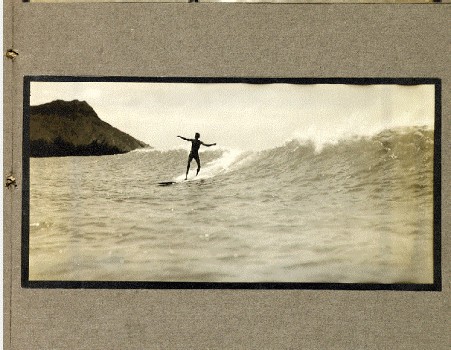 |
right when they advised, "It takes experience; just keep at
it; some day you'll learn the trick, and then you'll wonder
how it was you didn't get it the first day."
I learned in half an hour the secret I had sought for weeks.
A young hapahaole (half- white, half-native) took pity on
me.
He was the champion surfer of the Island - who, on a brief
visit to America once astonished the natives of Atlantic
City and was arrested by the police for riding in on an
ironing board upon the top of a great roller, to the seeming
peril of the hundreds of conventional bathers in the surf -
the first time in America, doubtless, that the little board
was used in our breakers - and half an hour after this hero
took me in hand I was riding the surf to my heart's content.
The first bit of instruction from my new tutor was to
balance myself; he showed me how in shallow water he could
stand until the
wave was almost upon him, and then spring sideways upon the
board, balancing so that resting on the tips of two ribs he
could wheel about as on a pivot - then he showed me how, in
deep water, to mount my plank with a side-ways motion.
My premier lesson was in the shallows.
"First," said my instructor, "I want you to learn how to go
before a wave; get on your board, now put your arms out
straight, perfectly rigid—go."
The wave came, there was a gentle shove from behind, I
kicked my feet up and down as instructed, and shot forward -
it was a complete success.
The next time I bent my elbows and slipped back through the
wave.
"That acts as a brake," said my instructor; "as long as you
keep your arms rigid you can go before the smallest wave,
but the moment you bend them, back you slide.
If you want to get up on your board, jerk yourself up
quickly without bending your elbows.
And so, with sensible hints here and there, my instructor
quickly initiated me into the mysteries of the board; its
secrets became mine.
When I would get a fair start and bring up broadside to the
wave, my tutor was there to stop me.
Soon I learned, by balancing myself amidships and waving my
legs, from the hips down, either one side or the other, to
perfectly guide my board before any kind of breaker.
In a little while this method seemed to be acquired most
naturally.
I was ready now to practice by myself, first in the
shallows, springing on my board with a forward shove just
before the wave broke, and catching its momentum - and in
deep water by remaining on my board and watching for the
proper wave.
But there again I had to be taught how to judge the waves
and which to trust myself upon - in fact, with the
instruction of a
man who knows how to teach, anyone may acquire the art of
surfboarding to perfection.
Our Navy, the Standard Publication of the U.S.
Navy
Volume 7 Number 10, February 1913
Page 45
"CIRCUS STUNTS"
Copyrighted by A. R. Gurrey,
Jr.
Not the exact image, but
similar.
|
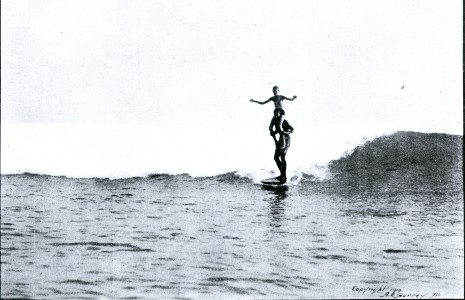 |
A familiar sight at the famous bathing
beach at Waikiki, Honolulu, Hawaii.
The Hawaiian youth, trained to the water from infancy is
perhaps the most expert swimmer in the world.
The "stunts" executed on their surf-boards may be favorably
compared in points of skill and daring with the ski-runners
of the Scandinavian peninsula.
Much practice is required to enable one to navigate a
surf-board and the efforts of men-o'-warsmen to master the
art is a source
of much merriment to the natives.
That this sport is not indulged in on the Atlantic coast at
the popular beaches is due to the fact that a certain form
of wave is
necessary in order to cause the board to ride on its crest.
Our Navy, the Standard Publication of the U.S.
Navy
Volume 7, Number 11, March 1913
Page 37
KILLS EEL WITH
BARE HANDS.
"Duke" Kahanamoku, the world's champion swimmer, killed a
gigantic eel that attacked and drew him ten feet under the
water, with his bare hands on January 27, at Waikiki,
Honolulu, Hawaii.
The young Hawaiian lost the index finger of his right hand
in his battle with the monster which lasted for over two
minutes under
water.
He was unconscious when rescued by companions and the body
of the eel, the largest ever seen in Hawaiian waters, was
floating
near.
It had been choked by the intrepid swimmer.
Mr. Kahanamoku was winner of the chief aquatic honors at the
Olympian games in Sweden last year, and his article in OUR
NAVY
a few months ago on surf-riding, at which sport he is a
champion, drew much favorable comment from our readers.







